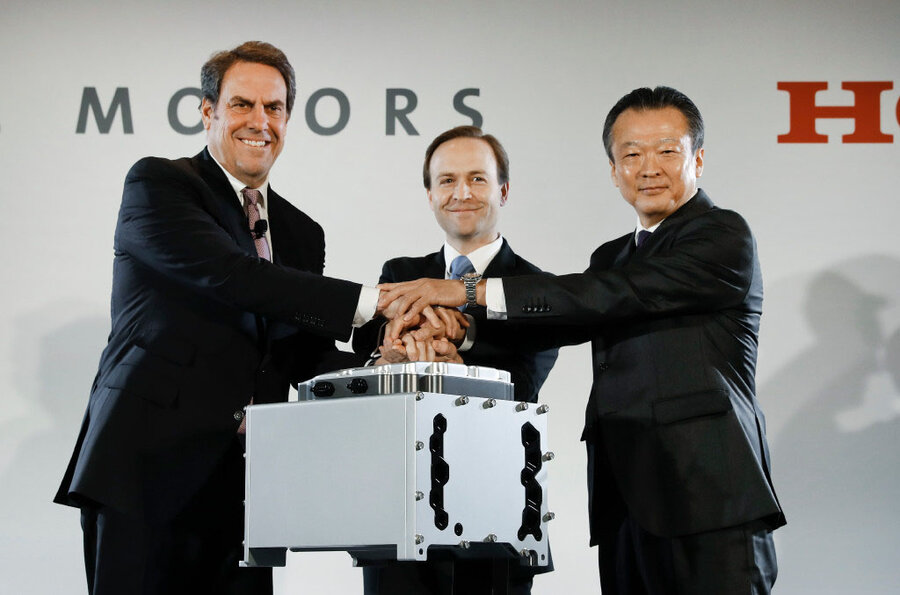Can GM and Honda's new fuel cell plant overcome a lack of infrastructure?
Loading...
On Monday, Honda and General Motors set aside their commercial rivalry to announce an $85 million collaboration. In 2020, a Brownstown, Michigan GM plant will begin assembling hydrogen fuel cells for both companies to use in their vehicles.
These devices take in hydrogen gas from a storage tank and oxygen from the air, then trigger a chemical reaction that produces an electrical current, with only water as a by-product. GM first applied the technology to cars in 1966, adapting a GMC Handivan to run on hydrogen. It and Honda have been collaborating on the technology since 2013, and have between them filed for more than 2,220 fuel cell-related patents.
With electric vehicle sales on the rise, mass-producing fuel cells might seem like a smart investment for GM and Honda, and further evidence that the auto industry is shifting away from fossil fuels. But when hydrogen-powered cars hit the road, they’ll need places to refuel. That reality makes this move a risky investment.
“I think that fuel cell vehicles have a tremendous future,” Eric Wachsman, director of the University of Maryland Energy Research Center, tells The Christian Science Monitor. “It’s going to require that there are enough vehicles on the road to have somebody invest in the hydrogen fueling infrastructure. But you also have to have enough people willing to buy the vehicles. So you have kind of a chicken-and-egg-type situation.”
The costs of installing that infrastructure augur poorly for the future of fuel cell-powered vehicles. As part of a California program meant to nurture the technology, each of the state's 28 hydrogen refueling stations requested an average of $1.93 million in state grants, according to a report published last year. That’s well above the $6,000 that an electric-vehicle charging station in a parking garage costs.
The challenges of building a hydrogen-fueling infrastructure, along with the need to use energy to separate hydrogen from water or natural gas for use in fuel cells, led Tesla Motors founder Elon Musk to dismiss what he called “fool cell vehicles.” These hurdles have also been cited to explain why the “hydrogen economy” predicted in the early 2000s hasn’t yet materialized.
These challenges might continue. A November 2016 study by researchers at Stanford University and the Technical University of Munich examined the costs of generating energy for the vehicle fleet of Los Altos Hills, Calif., in 2025 and 2035. It concluded that:
While both battery vehicles and fuel cell vehicles can modestly reduce the community's overall carbon dioxide emissions, the latter carry higher overall costs, primarily due to the hydrogen generation infrastructure. Battery vehicles are therefore a more cost-efficient choice for reducing CO2 emissions.
But there may be reason to hold out hope for fuel cells. In 2017, Honda began selling the hydrogen-powered Clarity in California. With a range of 366 miles, it can go far beyond the 238 miles that Chevy’s battery-powered Bolt EV covers on a single charge.
This relatively long range means that not every gas station needs to be fitted with a hydrogen pump. In fact, a 2013 study found that only “68 strategically located fueling stations” would be necessary to encourage adoption of the technology in California.
The state’s push to expand the technology, combined with its other advantages – for instance, five minutes to fill the tank, versus as much as five hours to charge a battery – could make fuel-cell powered cars palatable to consumers.
One of the partners in this new joint venture seems to be banking on this outcome. “Honda believes that America is the world's largest market for fuel cells,” spokesperson Jessica Pawl tells the Monitor in an email. “We believe that fuel cells will be the key technology for clean energy for future automobiles. Whether or not we can create a market for it will also depend on the establishment of H2 infrastructure, which we plan to make a continuous contribution in as well.”
But General Motors is taking a more cautious approach. “GM has not announced a passenger vehicle program” for fuel cells, GM spokesman Alan Adler says in a separate email. “Our current focus is on land, sea and air applications for military and aerospace.”
That could prove a safer course. Fuel cells have been producing electricity and drinking water aboard spacecraft since the Gemini missions of the 1960s, using the hydrogen gas given off as a by-product of rocket combustion.
While these companies have different goals, the University of Maryland's Dr. Wachsman says that their collaboration could help solve the challenges of making hydrogen widely available: generating it more efficiently, transporting it more safely, and, ultimately, bringing an H2 pump to your local gas station.
“Joint ventures like this are critical to their success,” Wachsman says of fuel cells, “because not only do they have to develop the hydrogen fuel cell, but also the hydrogen tank, and also the entire fueling and storage infrastructure.”






